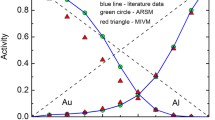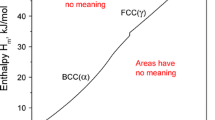Abstract
Modern computational thermodynamics methods rely on the use of numerical models that represent chemical systems. Typically, these models are formulated in terms of the Gibbs energy, which must be minimised to find the conditions of thermodynamic equilibrium. Numerous thermodynamic models have been developed to capture the behaviour of regular solid and liquid solutions, ionic ceramics, multi-sublattice metallic alloys, short and long range ordering, and much more. Some classes of commonly used thermodynamic models include substitutional solutions and compound energy formalism. The mathematical formulation of the Gibbs energy of a solution phase represented by any of the aforementioned models takes on a unique form, which requires special consideration for obtaining the partial derivatives in the Hessian matrix of a Gibbs energy minimiser. This paper provides derivations of the partial molar excess Gibbs energy of mixing of some common classes of thermodynamic models for use in a Gibbs energy minimiser.

Similar content being viewed by others
Notes
Unless specified otherwise, all the expressions for chemical potentials account for the chain rule and the expressions from the referenced equations can be directly substituted.
References
L. Kaufman, H. Bernstein, Computer Calculation of Phase Diagrams—With Special Reference to Refractory Metals (Academic Press, London, 1970).
W. White, S. Johnson, G. Dantzig, Chemical Equilibrium in Complex Mixtures. J. Chem. Phys. 28(5), 751 (1958)
M. Piro, S. Simunovic, T. Besmann, B. Lewis, W. Thompson, The Thermochemistry Library Thermochimica. Comput. Mater. Sci. 67, 266 (2013)
P. Bajpai, M. Poschmann, D. Andrš, C. Bhave, M. Tonks, M. Piro, in TMS 2020 149th Annual Meeting and Exhibition Supplemental Proceedings (Springer, 2020), pp. 1013–1025
J.J. Van Laar, Die schmelz-oder erstarrungskurven bei binären systemen, wenn die feste phase ein gemisch (amorphe feste lösung oder mischkristalle) der beiden komponenten ist. Z. Phys. Chem. 63(1), 216 (1908)
O. Redlich, A.T. Kister, Algebraic Representation of Thermodynamic Properties and the Classification of Solutions. Ind. Eng. Chem. 40(2), 345 (1948)
M. Hillert, Empirical Methods of Predicting and Representing Thermodynamic Properties of Ternary Solution Phases. Calphad 4(1), 1 (1980). https://doi.org/10.1016/0364-5916(80)90016-4
F. Kohler, Estimation of the Thermodynamic Data for a Ternary System from the Corresponding Binary Systems. Monatshefte für Chemie - Chem. Mon. 91(4), 738 (1960)
G.W. Toop, Predicting ternary activities using binary data. Trans. Metall. Soc. AIME 223, 850 (1965)
C. Colinet, Estimation Des Grandeurs Thermodynamiques Des Alliages Ternaries (DES, Faculté Des Sciences, Université de Grenoble, France, 1967).
Y.M. Muggianu, M. Gambino, J.P. Bros, Enthalpies de formation des alliages liquides bismuth-étain-gallium à 723 K. choix d’une représentation analytique des grandeurs d’excès intégrales et partielles de mélange. J. Chim. Phys. 72, 83 (1975)
M.H. Piro (ed.), Advances in Nuclear Fuel Chemistry. Woodhead Publishing Series in Energy (Woodhead Publishing, Sawston, 2020), pp. 159–182. https://doi.org/10.1016/B978-0-08-102571-0.00004-5
P. Chartrand, A. Pelton, On the Choice of Geometric Thermodynamic Models. J. Phase Equilib. 21(2), 141 (2000)
I. Ansara, Comparison of Methods for Thermodynamic Calculation of Phase Diagrams. Int. Met. Rev. 24(1), 20 (1979)
G. Eriksson, K. Hack, Chemsage—A Computer Program for the Calculation of Complex Chemical Equilibria. Metall. Mater. Trans. B 21B, 1013 (1990)
M. Hillert, The Compound Energy Formalism. J. Alloys Compd. 320(2), 161 (2001). https://doi.org/10.1016/S0925-8388(00)01481-X
B. Sundman, J. Ågren, A Regular Solution Model for Phases with Several Components and Sublattices, Suitable for Computer Applications. J. Phys. Chem. Solids 42, 297 (1981)
Acknowledgments
This research was funded, in part, by the U.S. Department of Energy Nuclear Energy Advanced Modeling and Simulation program. This research was undertaken, in part, thanks to funding from the Canada Research Chairs program and the Discovery Grant Program of the Natural Sciences and Engineering Research Council of Canada.
Author information
Authors and Affiliations
Corresponding author
Additional information
Publisher's Note
Springer Nature remains neutral with regard to jurisdictional claims in published maps and institutional affiliations.
Supplementary Information
Below is the link to the electronic supplementary material.
Rights and permissions
About this article
Cite this article
Bajpai, P., Poschmann, M. & Piro, M.H.A. Derivations of Partial Molar Excess Gibbs Energy of Mixing Expressions for Common Thermodynamic Models. J. Phase Equilib. Diffus. 42, 333–347 (2021). https://doi.org/10.1007/s11669-021-00886-w
Received:
Revised:
Accepted:
Published:
Issue Date:
DOI: https://doi.org/10.1007/s11669-021-00886-w




